Research on the Efficient Desilication Process of Low-Grade Bauxite in Guangxi
Abstract
1. Introduction
2. Materials and Methods
2.1. Experimental Principle
2.2. Experimental Raw Materials and Reagents
2.3. Experimental Methods
2.3.1. Pre-Desiliconization of Bauxite Slurry
2.3.2. Dissolution of Aluminum Hydroxide
3. Results
3.1. Pre-Desiliconization of Bauxite Slurry by Barium Hydroxide Powder
3.2. Influence of Insulation Time on Leaching Performance of Aluminum Hydroxide
3.3. XRD and SEM Analyses of Dissolved Aluminum Hydroxide
4. Conclusions
- (1)
- This study systematically explored the pre-desilication process of barium hydroxide based on the characteristics of high silicon content and a low aluminum/silicon ratio in a low-grade bauxite mine in Guangxi, aiming to improve the aluminum/silicon ratio and optimize the subsequent alumina production process. The research results indicate that, to a certain extent, the desilication effect is positively correlated with the amount of barium hydroxide added and the holding time, and negatively correlated with the reaction temperature. The research results provide the possibility of achieving efficient desilication technology for low-grade bauxite and improving the utilization rate of mineral resources, thereby better meeting the demand for alumina production in Guangxi and promoting economic development.
- (2)
- In this paper, adding 3 g of barium hydroxide powder to 100 mL bauxite slurry and keeping it at a temperature of 25 °C for 50 min can achieve the best desilication effect. The experimental results showed that, under this condition, the desilication rate reached 97.53%, and the aluminum/silicon ratio was significantly improved, exceeding the control line required for the production of alumina by the Bayer process. At the same time, the properties of the barium silicate precipitate generated by the barium hydroxide method for desilication are relatively stable, and it has a weak adsorption effect on aluminum ions, which can effectively reduce the loss of aluminum during desilication, reduce aluminum loss, and effectively solve the problems of high aluminum loss (5–10%) in the traditional lime method and serious environmental pollution in the acid method.
- (3)
- The research results have demonstrated certain value and advantages in terms of economy and resource utilization. In terms of economy, after desilication treatment with barium hydroxide, the aluminum/silicon ratio of the slurry significantly increases, exceeding the control line required by the Bayer process for producing alumina. This advantage greatly reduces the burden of desilication in the subsequent process of producing alumina using the Bayer process, and correspondingly reduces the equipment investment, chemical reagent consumption, and energy consumption required in the subsequent desilication process, thereby effectively reducing the cost of alumina production and improving the economic efficiency of the enterprise.
- (4)
- Future research can further focus on the development of barium salt cycle process, the collaborative removal mechanism of fine silicon particles, and the optimal design of industrial continuous reaction devices, in order to deepen the application potential of technology and help the efficient development and industrial upgrading of bauxite resources in China.
Author Contributions
Funding
Data Availability Statement
Conflicts of Interest
References
- Zhang, H.; Hu, P.; Jiang, J.; Cheng, X.; Wang, J.; Liu, J.; Xiang, P. Distribution, genetic types and current situation of exploration and development of bauxite resources. Geol. China 2021, 48, 68–81. [Google Scholar]
- Chen, Y.; Long, F.; Cao, X.; Li, Y.; Zhang, W.; Zhang, T.; Lv, G. Exploration of Large-Scale Application of Efficient and Clean Utilization of Low-Grade Bauxite. Separations 2023, 10, 336. [Google Scholar] [CrossRef]
- Rao, D.S.; Das, B. Characterization and beneficiation studies of a low grade bauxite ore. J. Inst. Eng. Ser. D 2014, 95, 81–93. [Google Scholar] [CrossRef]
- Modi, M.; Dewangan, P. Beneficiation of Bauxite Ore Characterized by Low-Grade and High Silica Content Using Crushing and Scrubbing Technique. Int. J. Eng. Trends Technol. 2024, 72, 207–213. [Google Scholar] [CrossRef]
- Papadopoulos, N.; Karayianni, H.-S.; Hristoforou, E.; Metaxa, E. Valuable Products Obtained from Red Mud. GR2010000003. 15 July 2010. [Google Scholar]
- Gibson, B.; Wonyen, D.G.; Chelgani, S.C. A review of pretreatment of diasporic bauxite ores by flotation separation. Miner. Eng. 2017, 114, 64–73. [Google Scholar] [CrossRef]
- Zhao, X.; Liu, Y.; Wang, L.; Hua, Y.; Cheng, T.; Zhang, T.; Zhao, Q. Co-Extraction of Aluminum and Silicon and Kinetics Analysis in Carbochlorination Process of Low-Grade Bauxite. Materials 2024, 17, 3613. [Google Scholar] [CrossRef] [PubMed]
- Shah, S.S.; Palmieri, M.C.; Sponchiado, S.R.P.; Bevilaqua, D. Environmentally sustainable and cost-effective bioleaching of aluminum from low-grade bauxite ore using marine-derived Aspergillus niger. Hydrometallurgy 2020, 195, 105368. [Google Scholar] [CrossRef]
- Ren, S.P.; Xiong, T.; Zhou, Y.C. Study and application of desilication process in mineral processing. Min. Metall. 2013, 10, 195–197. [Google Scholar]
- Massola, C.P.; Lima, J.R.B.; Andrade, C.F. Separation of silica from bauxite via froth flotation. Miner. Eng. 2009, 22, 315–318. [Google Scholar] [CrossRef]
- Abroon, A.; Rahimdad, A. Desilication and flotation techniques for separating them from the bauxite. Adv. Environ. Biol. 2014, 8, 1280–1288. [Google Scholar]
- Xu, Y.; Chen, C.; Li, J. A Novel Sustainable and Facile Method in Alumina Industry: Pre-Treatment of High Silica Bauxite by Cyclic Alkaline Leaching. J. Sustain. Metall. 2025, 11, 645–656. [Google Scholar] [CrossRef]
- Jiang, Z.; Xia, F.; Zhang, S.; Zhang, Q.; Zhang, M. Study on efficient desulfurization and desilication process of low-grade bauxite. Nonferrous Met. Sci. Eng. 2022, 13, 26–34. [Google Scholar]
- Sun, Y.; Pan, A.; Ma, Y.; Chang, J. Extraction of alumina and silica from high-silica bauxite by sintering with sodium carbonate followed by two-step leaching with water and sulfuric acid. RSC Adv. 2023, 13, 23254–23266. [Google Scholar] [CrossRef] [PubMed]
- Shah, S.S.; Palmieri, M.C.; Sponchiado, S.R.P.; Bevilaqua, D. A sustainable approach on biomining of low-grade bauxite by P. simplicissimum using molasses medium. Braz. J. Microbiol. 2022, 53, 831–843. [Google Scholar] [CrossRef] [PubMed]
- Wang, Q.; Sheng, X.-F.; He, L.-Y.; Shan, Y. Improving bio-desilication of a high silica bauxite by two highly effective silica-solubilizing bacteria. Miner. Eng. 2018, 128, 179–186. [Google Scholar] [CrossRef]
- Paz, S.P.A.; Angélica, R.S.; Kahn, H. Optimization of the reactive silica quantification method applied to Paragominas-type gibbsitic bauxites. Int. J. Miner. Process. 2017, 162, 48–57. [Google Scholar] [CrossRef]
- Wu, Y.; Pan, X.; Han, Y.; Yu, H. Novel Process and Mechanism for Chemical Desilication from Kaolinite-Rich Diasporic Bauxite. J. Northeast. Univ. (Nat. Sci.) 2019, 40, 1424–1429. [Google Scholar]
- Yin, Z.; Gu, S. Influence of lime adding method on scaling process in Bayer preheating process of diasporic bauxite slurry. Chin. J. Nonferrous Met. 2001, 11, 910–914. [Google Scholar]
- Dobra, G.; Garcia-Granda, S.; Iliev, S.; Cotet, L.; Negrea, P.; Duteanu, N.; Boiangiu, A. Aluminum hydroxide impurities occlusions and contamination sources. Rev. Chim. 2020, 71, 65–76. [Google Scholar] [CrossRef]
- Zhang, Z.Y. Experimental study on digestion of gibbsite and boehmite mixture. Light Met. 2019, 1, 10–13. [Google Scholar]
- Smith, P. The processing of high silica bauxites—Review of existing and potential processes. Hydrometallurgy 2009, 98, 162–176. [Google Scholar] [CrossRef]
- Wang, Y.; Liu, W.; Liu, W.; Chen, M.; Hu, L. Two-step acid leaching extraction of Fe&Al from karst bauxite and optimization experimental study. Chem. Eng. Process.-Process Intensif. 2025, 208, 110131. [Google Scholar]

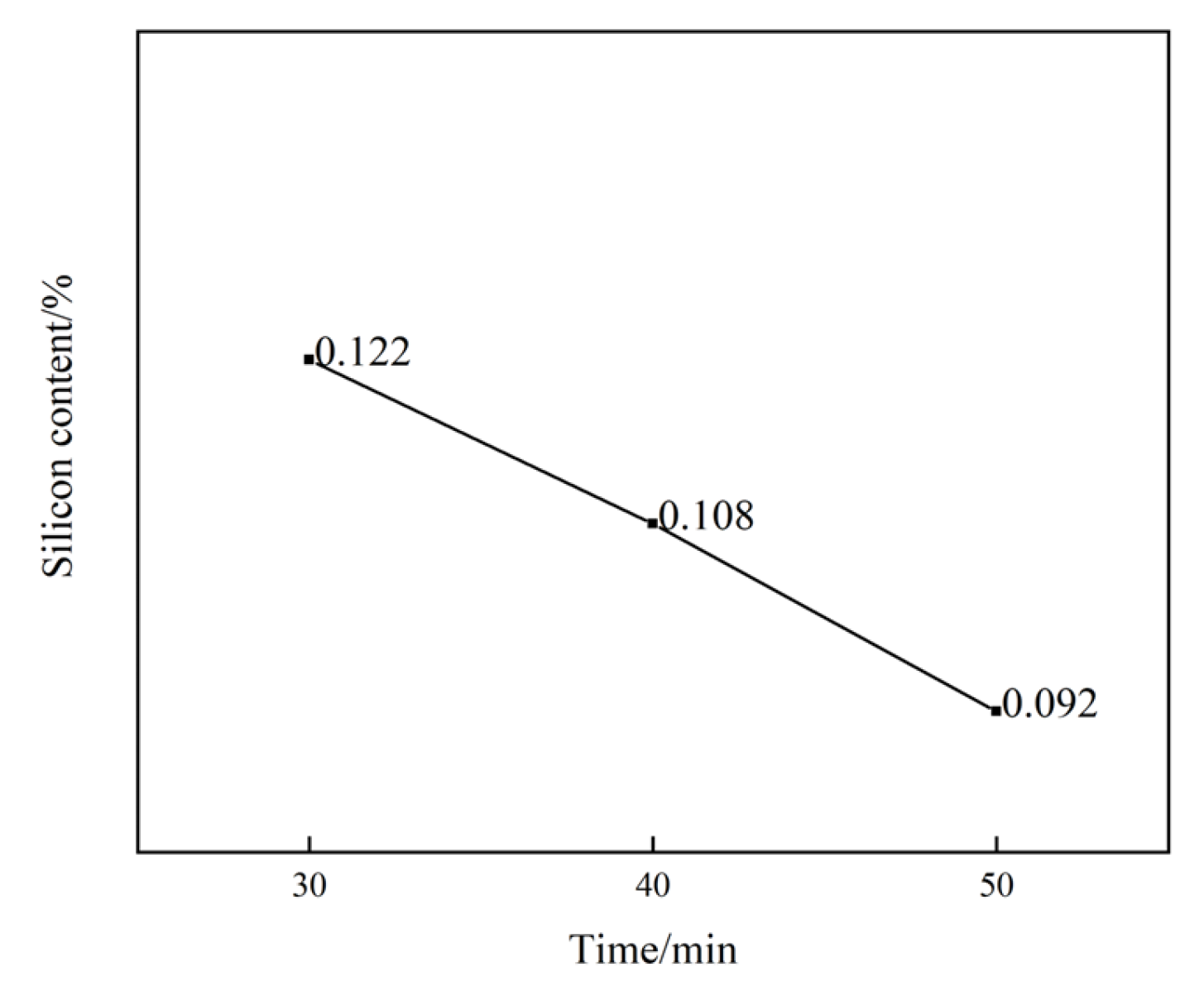
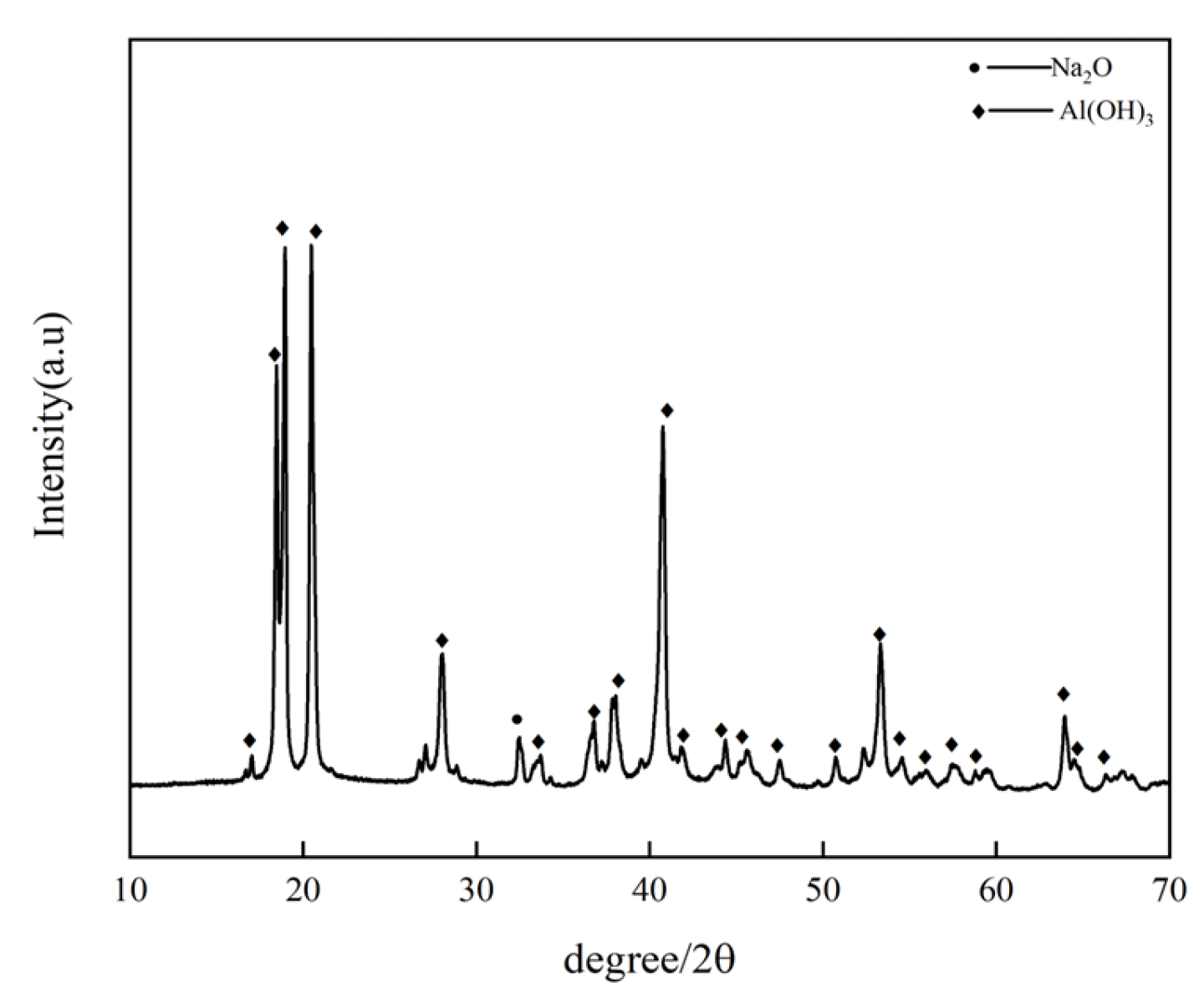
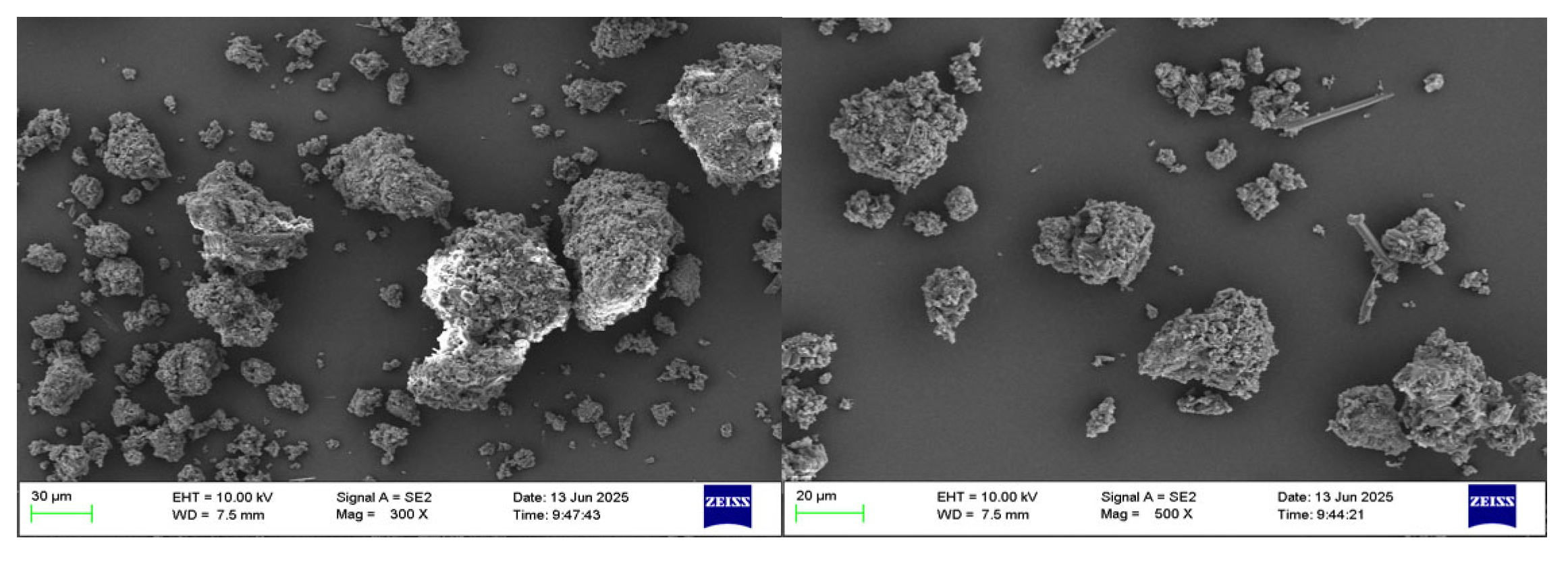

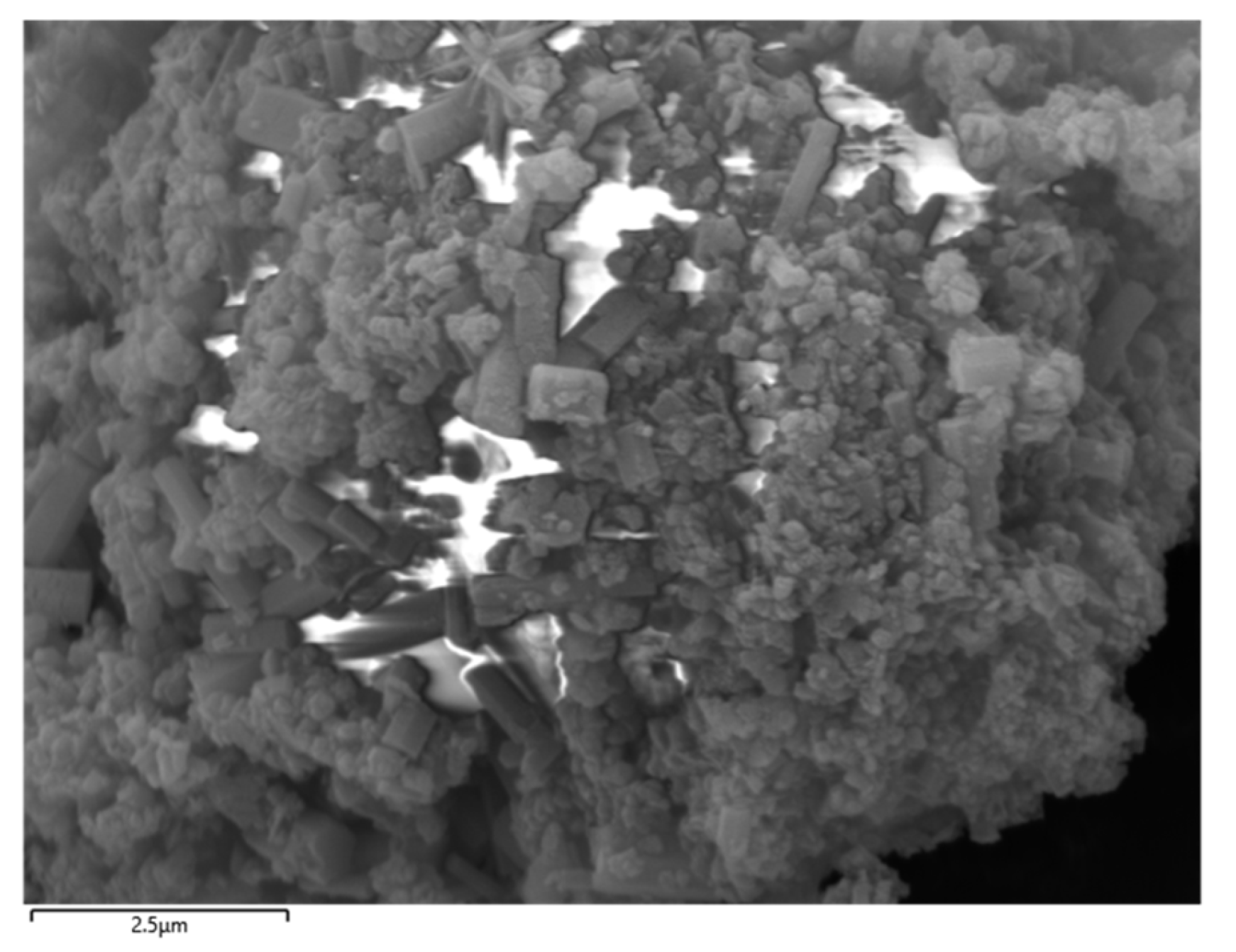
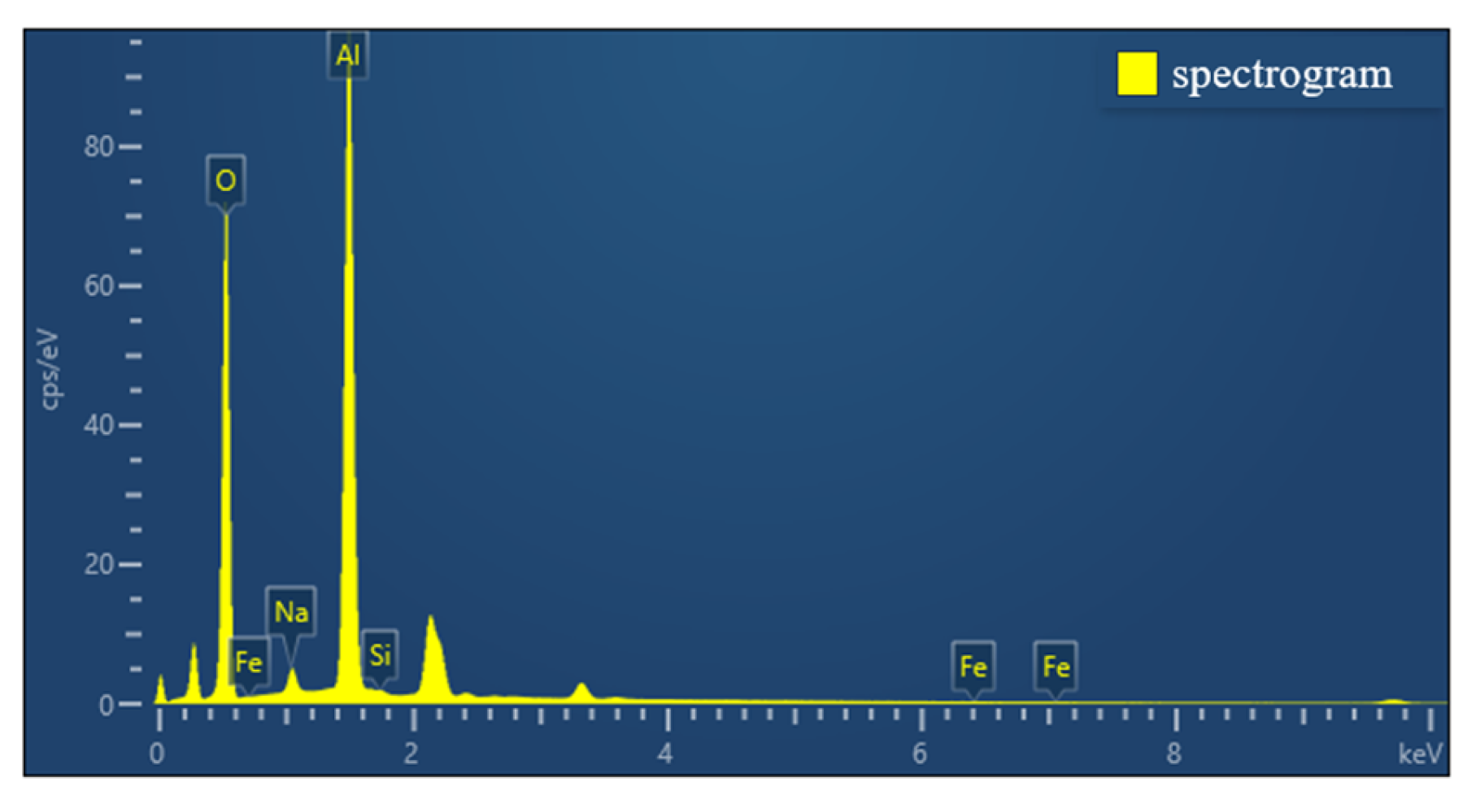
| Al2O3 | SiO2 | CaO | Fe2O3 | TiO2 | ω (Al/Si) |
|---|---|---|---|---|---|
| 50.00 | 8.60 | 0.25 | 22.87 | 3.62 | 5.82 |
| Al2O3 | SiO2 | Na2O | K2O | BaO | ω (Al/Si) |
|---|---|---|---|---|---|
| 31.28 | 10.29 | 39.96 | 14.38 | 1.15 | 3.04 |
| Number | 1 | 2 | 3 | 4 | 5 | 6 | 7 | 8 | 9 | 10 | 11 | 12 |
|---|---|---|---|---|---|---|---|---|---|---|---|---|
| Amount of barium hydroxide added/g | 2 | 2 | 2 | 3 | 3 | 3 | 3 | 3 | 3 | 3 | 3 | 3 |
| Temperature/°C | 25 | 25 | 25 | 25 | 25 | 25 | 25 | 50 | 60 | 70 | 80 | 90 |
| Time/min | 30 | 40 | 50 | 30 | 40 | 50 | 30 | 30 | 30 | 30 | 30 | 30 |
| Desilication rate/% | 96.77 | 96.87 | 97.13 | 97.30 | 97.02 | 97.53 | 96.94 | 96.70 | 96.62 | 96.91 | 96.44 | 96.41 |
Disclaimer/Publisher’s Note: The statements, opinions and data contained in all publications are solely those of the individual author(s) and contributor(s) and not of MDPI and/or the editor(s). MDPI and/or the editor(s) disclaim responsibility for any injury to people or property resulting from any ideas, methods, instructions or products referred to in the content. |
© 2025 by the authors. Licensee MDPI, Basel, Switzerland. This article is an open access article distributed under the terms and conditions of the Creative Commons Attribution (CC BY) license (https://creativecommons.org/licenses/by/4.0/).
Share and Cite
Hu, G.; Li, A.; Xia, A.; Zhang, D.; Pan, L.; Zhao, X.; Pang, X. Research on the Efficient Desilication Process of Low-Grade Bauxite in Guangxi. Crystals 2025, 15, 675. https://doi.org/10.3390/cryst15080675
Hu G, Li A, Xia A, Zhang D, Pan L, Zhao X, Pang X. Research on the Efficient Desilication Process of Low-Grade Bauxite in Guangxi. Crystals. 2025; 15(8):675. https://doi.org/10.3390/cryst15080675
Chicago/Turabian StyleHu, Guoxian, Anmin Li, An Xia, Dongjie Zhang, Liwen Pan, Xiaolian Zhao, and Xingzhi Pang. 2025. "Research on the Efficient Desilication Process of Low-Grade Bauxite in Guangxi" Crystals 15, no. 8: 675. https://doi.org/10.3390/cryst15080675
APA StyleHu, G., Li, A., Xia, A., Zhang, D., Pan, L., Zhao, X., & Pang, X. (2025). Research on the Efficient Desilication Process of Low-Grade Bauxite in Guangxi. Crystals, 15(8), 675. https://doi.org/10.3390/cryst15080675






